Welcome to an exploration of the latest innovations in post-growth city planning and design, where sustainability takes centre stage. As cities continue to expand rapidly, we must shift our focus from growth at all costs to designing urban environments that foster holistic flourishing for both people and the planet.
In this article, we’ll delve into some of the most exciting developments in the field of sustainable urban development, highlighting innovations in eco-friendly urban planning, smart cities, inclusive design, green infrastructure, future-proof transportation, and more. By the end of this article, you’ll have a better understanding of how cutting-edge urban design trends are shaping the way we live, work, and play in cities.
Key Takeaways:
- Post-growth city planning prioritizes holistic flourishing over traditional growth-focused approaches.
- Innovations in eco-friendly urban planning include regenerative city design, green infrastructure, and urban agriculture.
- Smart cities leverage technology to create more efficient, resilient, and sustainable urban environments.
- Inclusive urban design seeks to create cities that are accessible, equitable, and inclusive for all residents.
- Green infrastructure integrates natural elements into urban landscapes to enhance sustainability and resilience.
- Future-proof city planning embraces sustainable transportation solutions and circular economy principles.
Eco-Friendly Urban Planning: Regenerative City Design
With the urgent need for sustainable urban development, cities are increasingly turning to innovative approaches that prioritize regenerative city design. By restoring and enhancing natural ecosystems within urban areas, these strategies aim to create more resilient, livable, and eco-friendly cities.
Green Infrastructure
One key strategy is the development of green infrastructure, which involves integrating natural elements such as plants, trees, and water systems into urban landscapes. This can take many forms, including:
| Strategy |
Description |
| Green roofs |
Roofs covered in vegetation that help absorb rainwater and provide insulation |
| Permeable pavements |
Pavements that allow rainwater to seep through and be absorbed by the ground |
| Urban forests |
Groups of trees and other vegetation that provide numerous ecological and social benefits |
| Rainwater harvesting systems |
Systems that collect rainwater and store it for later use, reducing overall water consumption |
These innovative solutions not only enhance the natural environment but also provide numerous economic and social benefits, including improving air quality, reducing the urban heat island effect, and boosting community well-being.
Urban Agriculture
Another innovative approach to regenerative city design is urban agriculture, which involves cultivating crops and raising animals within urban areas. This can take many forms, from community gardens and rooftop farms to aquaponic systems and vertical farming.
Urban agriculture not only provides fresh, locally grown produce but also promotes community engagement, education, and job creation. It can also help reduce urban food deserts and improve food security.
Nature-Based Solutions
Nature-based solutions are another key aspect of regenerative city design, as they leverage natural systems and processes to address urban challenges.
“Nature-based solutions can deliver over one-third of the climate mitigation needed to limit global warming to 2°C while simultaneously providing multiple co-benefits such as improving water quality, reducing urban heat islands, improving biodiversity and providing opportunities for recreation and leisure.” – International Union for Conservation of Nature
Examples of nature-based solutions in urban areas include restoring wetlands to improve water quality, creating green corridors to enhance biodiversity, and using green roofs to reduce the urban heat island effect.

Incorporating regenerative city design into urban planning and development is crucial for creating sustainable, resilient, and thriving cities. By prioritizing green infrastructure, urban agriculture, and nature-based solutions, cities can enhance their natural environment while improving the quality of life for their residents.
Smart Cities and Sustainability: Integrating Technology for Urban Development
As cities continue to grow, the need for sustainable urban development has become increasingly pressing. Fortunately, technology can play a key role in creating more efficient, resilient, and sustainable urban environments. Smart city initiatives leverage technology to improve everything from energy efficiency to waste management, creating a more livable and equitable urban landscape.
One example of sustainable technology in cities is the use of intelligent transportation systems. These systems use data analytics to optimize the flow of traffic, reducing congestion and improving air quality. Additionally, electric vehicles and bike-sharing programs are becoming increasingly prevalent in urban areas, reducing reliance on fossil fuels and promoting sustainable mobility.
Another area where technology is making a difference in sustainable urban development is waste management. Smart bins equipped with sensors can track the amount of waste in real-time, allowing for more efficient collection and disposal. Automated sorting systems can also help to reduce contamination and increase recycling rates.
However, it is important to note that smart cities are not without their challenges. Privacy concerns and data security are paramount when it comes to implementing smart city technology. Additionally, there are concerns about the potential for technology to exacerbate existing inequities in urban areas.
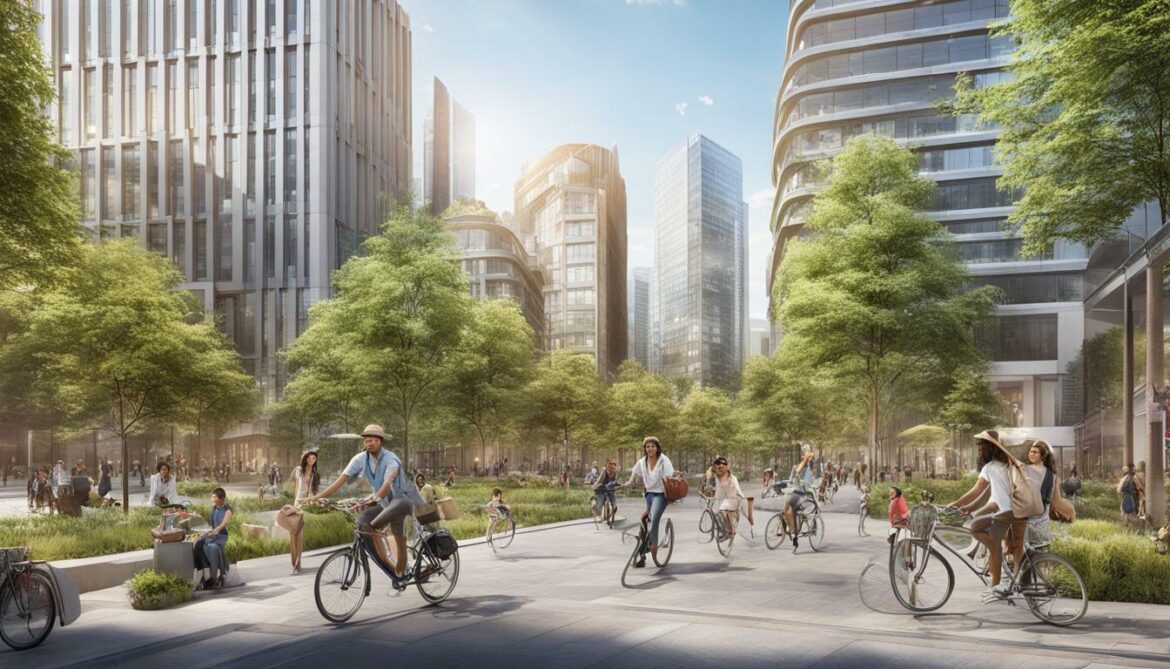
Despite these challenges, the integration of technology into sustainable urban development has the potential to create more livable, equitable, and resilient cities. By prioritizing the needs of residents and leveraging technology to create more efficient and sustainable urban environments, we can create cities that thrive for generations to come.
Inclusive Urban Design: Creating Cities for All
Creating cities that are accessible, equitable, and inclusive for all residents is essential for post-growth city planning and design. Inclusive urban design recognizes and accounts for the diverse needs of individuals, aiming to create urban spaces that are welcoming and accommodating for everyone.
One approach to inclusive urban design is through universal design principles, which involve designing spaces that can be used by as many people as possible, regardless of age, ability, or mobility. This may include features such as wider sidewalks, ramped curbs, and audible traffic signals for individuals with visual or hearing impairments.
Participatory planning processes are also essential to inclusive urban design, as they involve gathering input and feedback from a wide range of community members to ensure that everyone’s needs are considered and incorporated into the design process.
Additionally, accessible infrastructure is crucial to creating inclusive cities. This may include wheelchair-accessible public transport, accessible buildings and facilities, and inclusive public spaces that prioritize accessibility and mobility.
By prioritizing inclusive urban design, cities can create environments that are not only accessible to all but also foster a sense of community and social cohesion. It allows for everyone to feel included and valued within the urban landscape, creating a thriving, welcoming city for all.
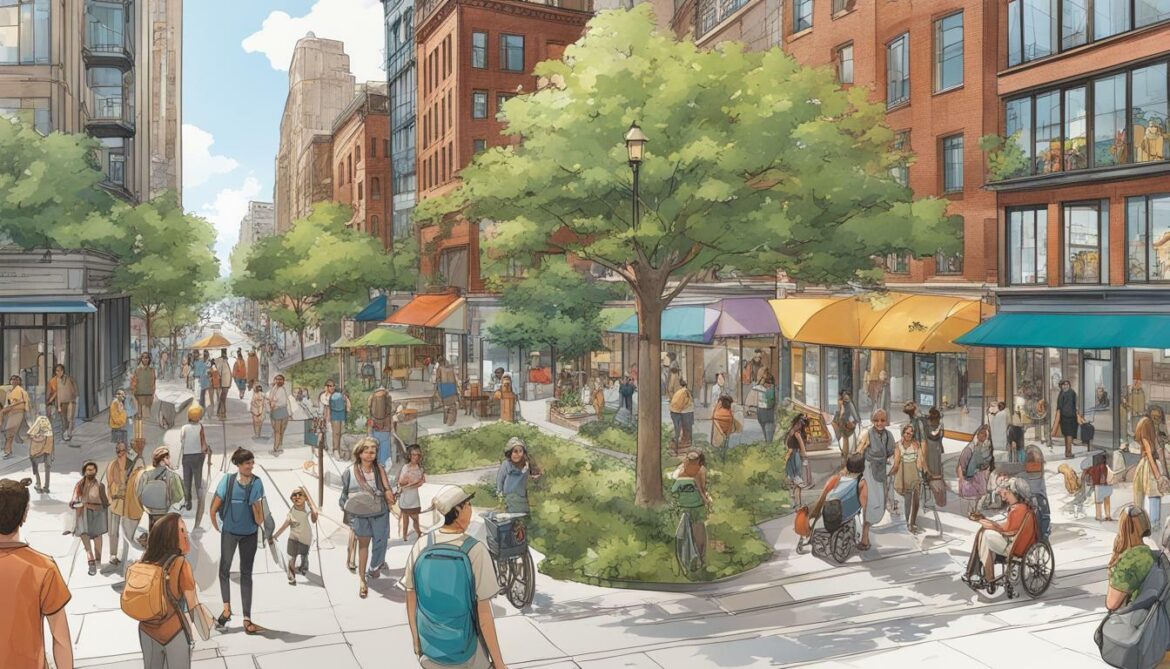
Green Infrastructure in Cities: Building Resilient Urban Landscapes
As urban areas continue to expand, incorporating green infrastructure into city planning has become increasingly important for sustainability and resilience. Green infrastructure refers to the natural and semi-natural systems that provide a range of benefits, including stormwater management, air purification, and climate regulation. By incorporating green infrastructure into urban design, cities can enhance their ecological, social, and economic sustainability.

Green infrastructure can take many forms, from small-scale solutions like green roofs and vertical gardens to larger initiatives like urban forests and park systems. For example, Philadelphia’s Green City, Clean Waters program aims to manage the city’s stormwater by using natural systems like rain gardens, permeable pavement, and green roofs. By doing so, the city not only manages its water more sustainably but also enhances its urban biodiversity and provides recreational opportunities for its residents.
Other examples of green infrastructure in cities include:
- Green corridors: These are linear networks of green spaces that can provide habitat for wildlife while also connecting urban areas.
- Street trees: By planting trees along sidewalks and roads, cities can improve air quality, reduce the urban heat island effect, and enhance the aesthetic appeal of their streetscapes.
- Brownfield redevelopment: By reusing contaminated sites for green infrastructure projects like parks, cities can turn previously unused land into valuable community assets.
Despite the many benefits of green infrastructure, there are also challenges associated with its implementation. These include the initial costs of installation, maintenance and management, and the need for public education and community engagement in the planning process.
“Green infrastructure refers to the natural and semi-natural systems that provide a range of benefits, including stormwater management, air purification, and climate regulation.”
Despite these challenges, the benefits of green infrastructure in cities cannot be overstated. By incorporating natural systems into urban landscapes, cities can enhance their sustainability and resilience, while also providing numerous social and economic benefits for their residents. As such, it is important that green infrastructure continues to be a priority in city planning and design.
Future-Proof City Planning: Sustainable Transportation and Beyond
In today’s urban landscape, sustainable transportation is an essential facet of future-proof city planning. As cities continue to grow, ensuring that residents can move around efficiently and with minimal environmental impact will become increasingly important.
One of the most notable sustainable transportation trends in recent years has been the rise of electric vehicles (EVs). With improvements in battery technology and charging infrastructure, EVs are becoming increasingly accessible and practical for everyday use. In fact, by 2025, it’s estimated that there will be over 145 million EVs on the road globally.
Another key component of sustainable transportation is the expansion of bike-sharing programs. These programs provide a low-cost, eco-friendly alternative to private cars and can help reduce traffic congestion while promoting exercise and healthy habits. Many cities around the world have already implemented successful bike-sharing schemes, with some even incorporating e-bikes or e-scooters into their fleets.
Pedestrian-friendly infrastructure is also a critical part of sustainable transportation. By creating safe, accessible walkways and encouraging walking as a viable means of transportation, cities can reduce reliance on cars and promote healthier lifestyles.
Intelligent transportation systems (ITS) are another key area of innovation in sustainable transportation. By utilizing data and technology, ITS can optimize traffic flow, reduce congestion, and minimize transit times. This can be achieved through the use of smart traffic lights, real-time route planning, and other advanced technologies.
Future-proof city planning, however, involves more than just sustainable transportation solutions. It also requires a commitment to circular economy principles, which involve reducing waste and repurposing materials to create a closed-loop system. By adopting circular economy approaches, cities can reduce their environmental impact and create new economic opportunities.
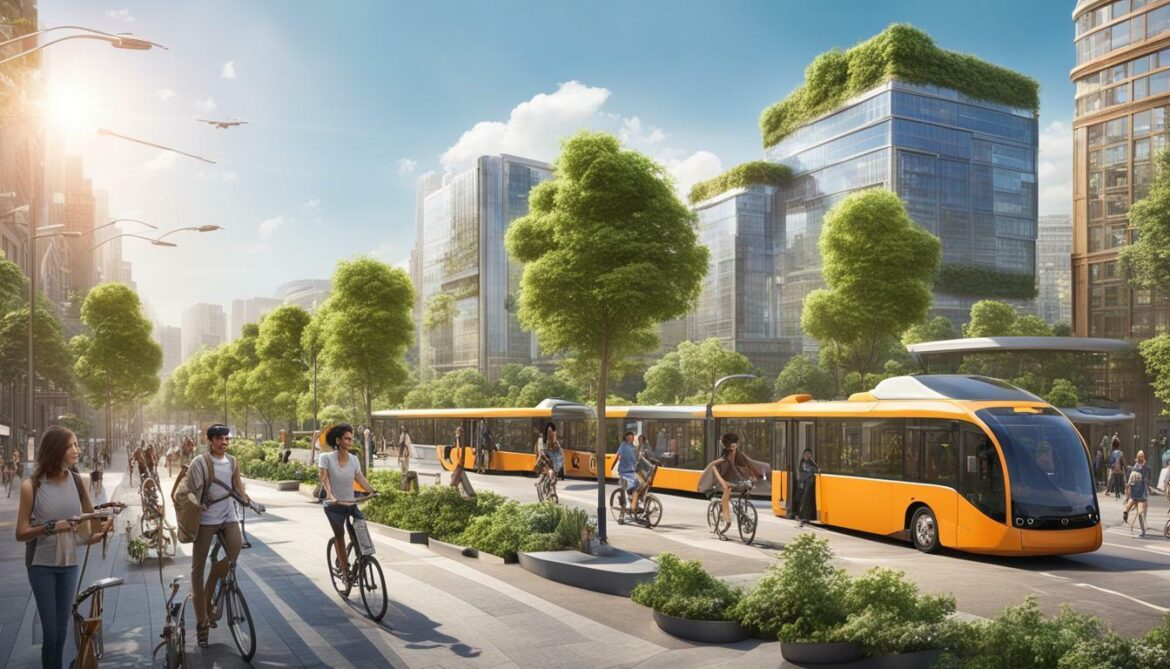
Overall, sustainable transportation is a critical component of future-proof city planning. By prioritizing eco-friendly modes of transport and embracing circular economy principles, cities can create more liveable, resilient, and sustainable urban environments.
Conclusion
In conclusion, post-growth city planning and design is an essential approach to creating sustainable, thriving urban environments. By prioritizing eco-friendly urban planning, smart cities and sustainability, inclusive urban design, green infrastructure, future-proof city planning, and sustainable transportation solutions, cities can build resilience, enhance natural ecosystems, and promote equity and accessibility.
The innovations discussed in this article represent a shift toward more holistic, regenerative approaches to urban development that prioritize the well-being of both people and the planet. As cities continue to grow and face new challenges, it is crucial that they embrace these innovative approaches and work collaboratively to create urban environments that are sustainable, thriving, and resilient.
FAQ
Q: What is post-growth city planning and design?
A: Post-growth city planning and design refers to an approach that prioritizes sustainable urban development and holistic flourishing rather than traditional growth-focused models. It aims to create cities that are environmentally friendly, socially inclusive, and economically resilient.
Q: What is eco-friendly urban planning?
A: Eco-friendly urban planning focuses on designing cities that have minimal environmental impact and promote the restoration and enhancement of natural ecosystems. It involves strategies such as green infrastructure, urban agriculture, and nature-based solutions to urban challenges.
Q: How can technology contribute to sustainable urban development?
A: Technology can play a crucial role in creating smart and sustainable cities. It can be utilized to improve energy efficiency, optimize waste management, enhance transportation systems, and enable data-driven decision-making for better urban living.
Q: Why is inclusive urban design important?
A: Inclusive urban design is essential for creating cities that are accessible, equitable, and inclusive for all residents. It involves considering diverse needs and ensuring that infrastructure and urban spaces are designed with universal design principles and participatory planning processes in mind.
Q: What is green infrastructure in cities?
A: Green infrastructure in cities refers to the integration of natural elements, such as green roofs, urban forests, and permeable pavements, into urban landscapes. It promotes sustainability and resilience by enhancing biodiversity, managing stormwater, and improving air quality.
Q: How can future-proof city planning contribute to sustainable urban development?
A: Future-proof city planning involves considering long-term sustainability and resilience in urban development. It includes innovative transportation solutions, such as electric vehicles and bike-sharing programs, as well as circular economy principles and climate change adaptation strategies.






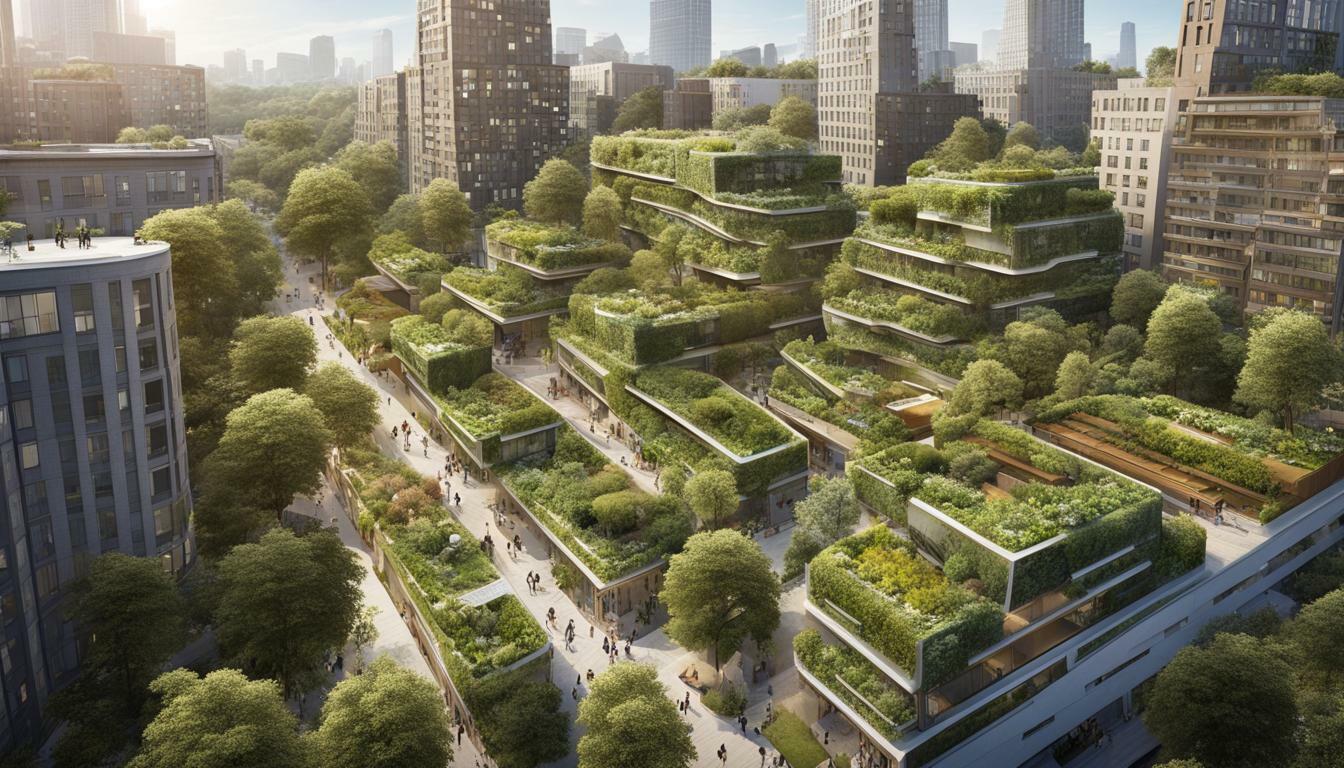





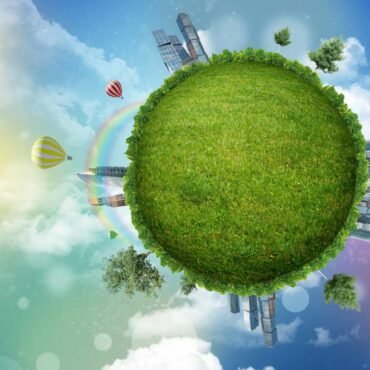










Post comments (0)